This post may contain affiliate links which may generate a small commission from clicks that result in a purchase.
When we think about the height of olive trees, it’s not a one-size-fits-all answer. There’re various olive trees, each with specific growth patterns and potential heights. Dwarf, semi-dwarf, standard or potted olive trees – they all have different stories to tell and heights to reach.
Understanding how tall do olive trees grow and their growth pattern can influence the layout of the landscape, the pruning schedule, and even the harvest process. Their growth pattern determines the sunlight exposure and can affect the tree’s health and productivity. It can also impact the neighboring plants and the overall look of your garden or orchard.
During our deep dive into this topic, we’ll explore the various aspects of olive tree growth. We’ll touch on the basics, understand the influences that environmental and genetic factors can have on height, and explore the range of heights across different species of olive trees. I’ll also share some insights on how the height of your olive tree can impact its olive production, and how it compares to the heights of other fruit trees.
Let’s grow together, understanding how tall olive trees can grow, and how we can help them thrive!
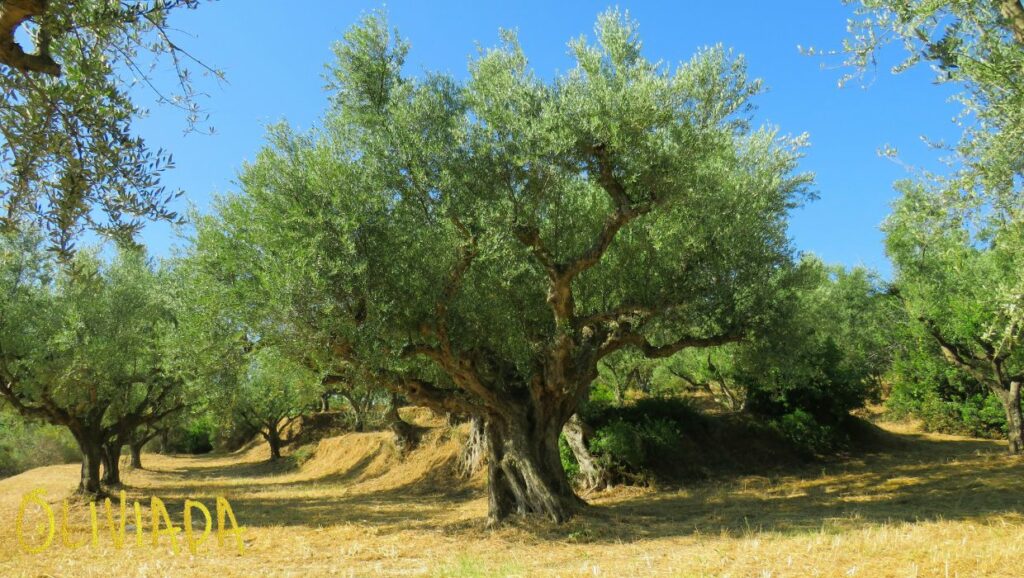
- I. How Tall Do Olive Trees Grow? Average Heights
- II. How Tall Do Olive Trees Grow in Pots?
- III. Oldest Olive Trees and Their Heights
- V. Comparing Olive Trees' Height to Other Fruit Trees
- VI. Factors Influencing the Height of Olive Trees
- VII. Methods to Control the Height of Olive Trees
- VIII. How the Height of Olive Tree Impacts Olive Production
- IX. Frequently Asked Questions
- X. Conclusion
- XI. References
I. How Tall Do Olive Trees Grow? Average Heights
1. Dwarf Olive Trees Height
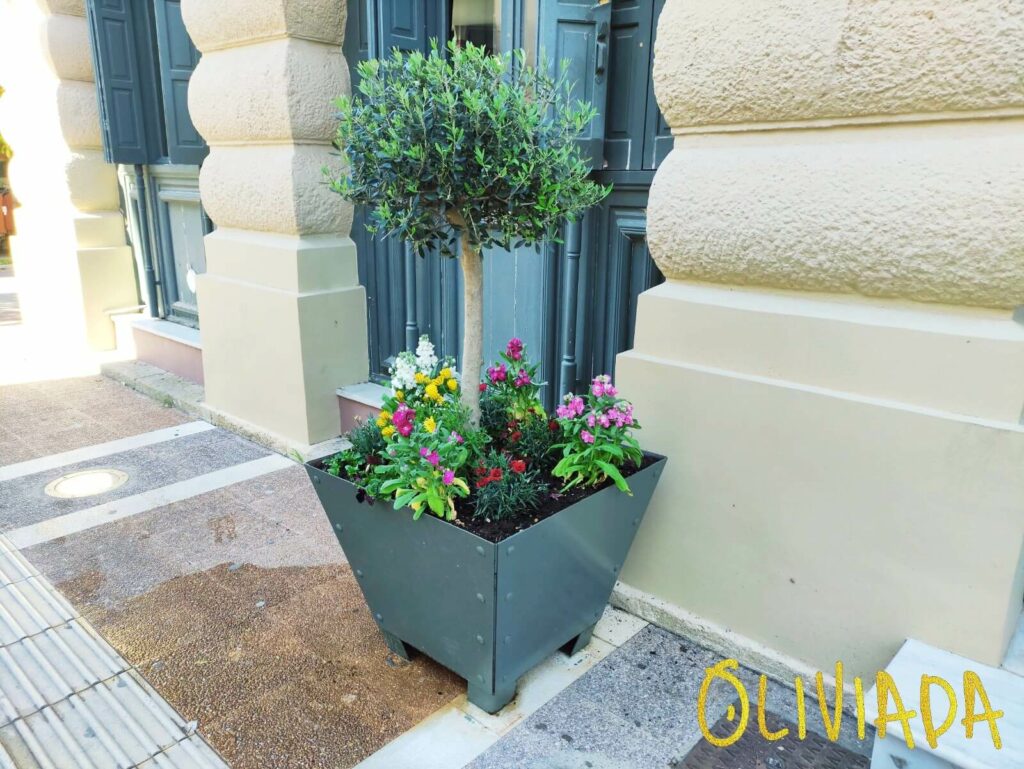
Dwarf olive trees are a popular choice for those with smaller spaces or who prefer to pot their trees. The beauty of dwarf olive trees is that they provide all the charm of a standard olive tree – the gnarled trunk, the silvery-green leaves – but in a size that fits perfectly on your patio, in a pot, or a small garden. They’re also popular with bonsai olive tree enthusiasts due to their small size and slow growth.
So how tall does a dwarf olive tree grow? On average, you can expect a dwarf olive to reach around 6 to 10 feet (1.80 to 3 meters) in height. That’s pretty compact, considering standard olive trees can grow 20 to 30 feet (6 to 9 meters) tall or more!
I’ve noticed that even though they’re small, dwarf olives are robust and hardy. They’re resilient to pests and diseases and adapt well to various soil conditions. Plus, their smaller stature means they’re easier to manage when it comes to pruning and harvesting.
a. Dwarf Olive Tree Size by Age
This table outlines the average growth progression of a dwarf olive tree by age:
| Age of Dwarf Olive Tree | Average Height (Feet) | Average Height (Meters) |
| At Planting (1 Year) | 1-2 Feet | 0.3-0.6 Meters |
| 3 Years | 3-4 Feet | 0.9-1.2 Meters |
| 5 Years | 5-6 Feet | 1.5-1.8 Meters |
| 7 Years | 6-8 Feet | 1.8-2.4 Meters |
| 10+ Years | 8-10 Feet | 2.4-3 Meters |
Remember, these are just averages. Factors such as the specific cultivar, growing conditions, and care practices can influence the actual growth of your dwarf olive tree.
For example, with good care and optimal conditions, a dwarf olive tree can reach its maximum height of 10 feet (3 meters) at around ten years of age. On the other hand, in less ideal conditions or with less frequent care, it might take a few more years for the tree to reach its full height.
And don’t worry if your tree seems to slow down in height after a certain point. As an experienced olive tree grower, I can tell you it’s perfectly normal. After reaching about half their full height, olive trees tend to slow down in vertical growth and instead start adding girth and branching out.
b. 5 Popular Dwarf Olive Varieties
Dwarf olive varieties are perfect for container gardening or smaller landscapes. Remember, despite their small size, these trees can provide ample olive harvests and are as enchanting as their larger relatives.
- ‘Little Ollie’ (Olea europaea ‘Montra’): It is perhaps the most well-known dwarf olive variety. ‘Little Ollie’ is a non-fruiting variant that grows up to 6 feet (1.8 meters) tall, perfect for creating low hedges or using it as an ornamental piece in a container.
- ‘Skylark Dwarf’ (Olea europaea ‘Skylark’): ‘Skylark Dwarf’ is an Australian variety that reaches around 10 feet (3 meters) tall. It’s both frost-hardy and drought-tolerant, producing small fruits with a deliciously robust flavor.
- ‘Picholine Marocaine’: Originating from Morocco, this variety stays compact, reaching a maximum height of about 8-10 feet (2.4-3 meters). It produces small, green olives with a distinct, slightly acidic flavor.
- ‘Frantoio Compact’: This Italian variety grows to about 10 feet (3 meters) high and is prized for its high-quality, flavorful olives often used in oil production. It’s also quite resistant to common olive diseases, making it an excellent choice for less experienced growers.
- ‘Bambalino’ (Olea europaea ‘Bambalino’): True to its name, ‘Bambalino’ is a compact olive tree that reaches only about 6-8 feet (1.8-2.4 meters) in height. It’s a favorite for container gardening due to its manageable size and appealing aesthetic.
2. Semi-dwarf Olive Trees Height
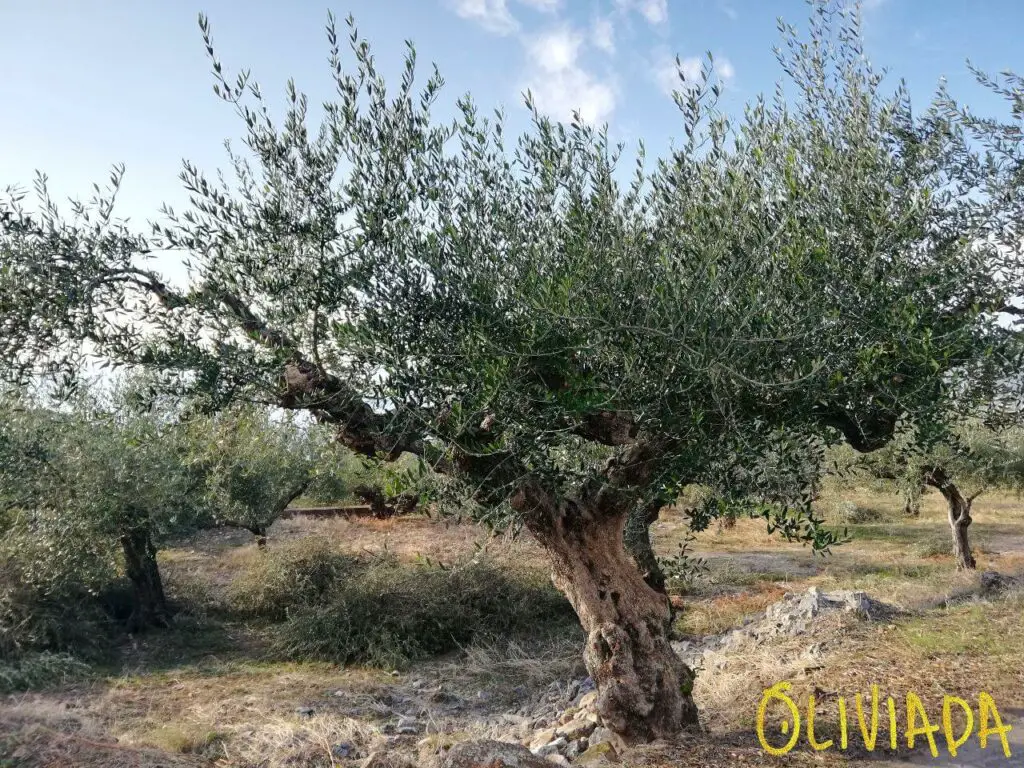
Semi-dwarf olive trees offer a middle ground for those who may find the standard olive tree too tall for their needs and the dwarf variety too petite. As the name suggests, semi-dwarf olive trees are taller than dwarf olives but shorter than their full-sized cousins.
How tall does a semi-dwarf olive tree grow? Typically, these olive trees can reach 12 to 15 feet (3.7 to 4.6 meters) in height when mature. But don’t worry; they don’t shoot up overnight! Like their dwarf and standard siblings, semi-dwarf olive trees are patient growers. They spend their early years developing a sturdy structure before reaching full height.
What I particularly love about semi-dwarf olive trees is their adaptability. They perform well in various environments and are as happy in the ground as in larger pots or containers. Their compact size makes them ideal for gardens or landscapes where space is limited but they still want to make a statement.
a. Semi-dwarf Olive Tree Size by Age
To give you a sense of their growth over time, here’s a basic table, including heights in both feet and meters:
| Age of Semi-dwarf Olive Tree | Average Height (Feet) | Average Height (Meters) |
| At Planting (1 Year) | 1-2 Feet | 0.3-0.6 Meters |
| 3 Years | 4-5 Feet | 1.2-1.5 Meters |
| 5 Years | 7-8 Feet | 2.1-2.4 Meters |
| 7 Years | 10-12 Feet | 3.0-3.7 Meters |
| 10+ Years | 12-15 Feet | 3.7-4.6 Meters |
b. 5 Popular Semi-dwarf Olive Varieties
I’d happily share some of my favorite semi-dwarf olive varieties with you. Each has unique characteristics, but they all share the semi-dwarf growth habit that makes them a great choice for various spaces.
- ‘Arbequina‘: Known for their high yield and aromatic olives, Arbequina trees are a favorite among commercial growers and home gardeners. They can reach up to 15 feet (4.6 meters) tall and are particularly suited for container growth.
- ‘Koroneiki‘: A Greek variety, Koroneiki trees produce flavorful small fruits. Despite their compact size (reaching 12-15 feet or 3.7-4.6 meters), these trees are very productive.
- ‘Leccino‘: An Italian variety, Leccino trees are appreciated for their resistance to cold weather. They can grow up to 15 feet (4.6 meters) tall and produce large, flavorful olives.
- ‘Pendolino’: Also from Italy, Pendolino trees are often used as pollinators in olive orchards, but they also produce a fair amount of small, high-quality olives. They typically reach heights of 12-15 feet (3.7-4.6 meters).
- ‘Sevillano’: Despite their Spanish origin, Sevillano trees have adapted well to the climates of California and Australia. They’re slightly larger than most semi-dwarf varieties, sometimes reaching up to 20 feet (6 meters), but can be kept smaller with proper pruning. They produce large, firm olives that are often used for table olives.
Remember, while these are all semi-dwarf varieties, their final size can be influenced by factors like growing conditions, rootstock, and pruning practices. It’s one of the things I love about growing olive trees — you have some control over how your trees grow and shape up!
3. Standard or Full-sized Olive Trees Height
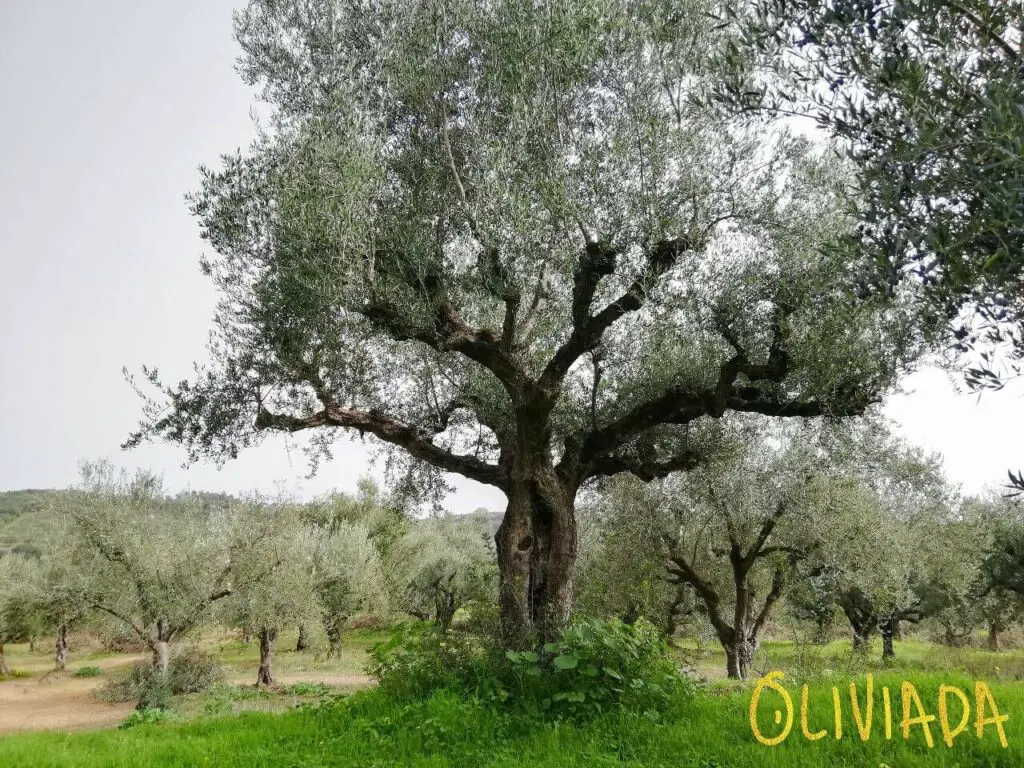
Full-sized olive trees can reach heights of anywhere from 20 to 30 feet (6 to 9 meters), and in some cases, even up to 50 feet (15 meters)! Though these trees are slow growers, taking many years to reach their full height.
Like all olive trees, full-sized varieties spend their initial years investing energy in root development and creating a solid structure. Over the years, they stretch toward the sky at their own steady pace.
What sets full-sized olive trees apart, apart from their height, is their commanding presence. With their wide, spreading canopies, they produce a bounty of olives and provide ample shade – a perfect spot for a summer picnic!
a. Standard Olive Tree Size by Age
Here’s a rough guideline for the average height progression of a standard olive tree:
| Age of Full-sized Olive Tree | Average Height (Feet) | Average Height (Meters) |
| At Planting (1 Year) | 1-2 Feet | 0.3-0.6 Meters |
| 3 Years | 4-5 Feet | 1.2-1.5 Meters |
| 5 Years | 8-10 Feet | 2.4-3 Meters |
| 10 Years | 15-20 Feet | 4.6-6 Meters |
| 20+ Years | 20-30+ Feet | 6-9+ Meters |
b. 5 Popular Standard Olive Varieties
Let’s explore some popular standard or full-sized olive tree varieties. Remember, these varieties can become quite tall and are ideal for larger landscapes.
- ‘Mission‘ (Olea europaea ‘Mission’): A classic and one of the oldest olive varieties grown in the United States, ‘Mission’ trees can reach heights up to 40-50 feet (12-15 meters). These trees are loved for their versatility, as the olives they produce can be used both for oil and as table olives.
- ‘Manzanillo‘ (Olea europaea ‘Manzanillo’): Native to Spain but now grown widely worldwide, ‘Manzanillo’ trees are known for their large, flavorful olives. These trees can reach heights between 25-30 feet (7-9 meters) and are a common sight in commercial olive groves.
- ‘Kalamata’ (Olea europaea ‘Kalamata’): Originating from Greece, Kalamata trees are beloved for their distinct, large, dark purple olives. These trees can grow up to 30 feet (9 meters) tall, providing a bountiful harvest and a striking landscape presence.
- ‘Picual’ (Olea europaea ‘Picual’): This Spanish variety is one of the most commonly grown olive trees worldwide, known for its high yield and excellent oil quality. These trees can reach up to 26 feet (8 meters) tall.
- ‘Picholine’ (Olea europaea ‘Picholine’): A French variety, Picholine trees can reach up to 30 feet (9 meters) tall. They are known for their green, medium-sized olives with a slightly tart flavor, often used for table olives or for producing subtly flavored olive oil.
Remember, your trees’ final size and productivity will depend on various factors, including your growing conditions and care practices.
II. How Tall Do Olive Trees Grow in Pots?
Olive trees in pots are surprisingly adaptable. Their final size is quite flexible and can be influenced by the size of their container. The bigger the pot, the more room for your olive tree to grow. But don’t worry, even in a smaller pot you’ll still have a healthy, happy tree – just on a smaller scale.
- Dwarf olive trees like Little Ollie or Skylark Dwarf can reach 6-10 feet (1.8-3 meters) in height, even in a pot, given the right care and conditions.
- Semi-dwarf varieties like Arbequina or Koroneiki can reach 10-15 feet (3-4.5 meters) in a large pot.
- Full-sized varieties like Manzanillo or Mission’ which can typically grow up to 20-30 feet (6-9 meters) in the ground, might reach about 10-15 feet (3-4.5 meters) in a pot.
Here’s a handy tip: If your tree’s growth seems slowing down, it might be root-bound. This happens when the roots fill the pot and can’t grow anymore. In this case, you can either repot your tree in a larger container or prune the roots and repot it in the same pot to maintain its current size.
What I love about growing olive trees in pots is that you have more control over their size. Through careful pruning and management, you can create a miniature olive tree that fits right on your patio, balcony, or indoors by a sunny window.
Looking for a Personalized Gift?
Adopt an OLIVE TREE in Greece –
Receive Premium Olive Oil!
III. Oldest Olive Trees and Their Heights
Each olive tree has a story to tell, especially those ancient ones that have seen centuries pass by. Here are a couple of the oldest olive trees and their staggering heights:
1. The Olive Tree of Vouves – Crete, Greece
This is arguably the oldest olive tree in the world, estimated to be over 3000 years old. Standing tall at about 33 feet (10 meters), this ancient tree continues to produce olives even today! Imagine that – olives from a tree that has been around since the Bronze Age!
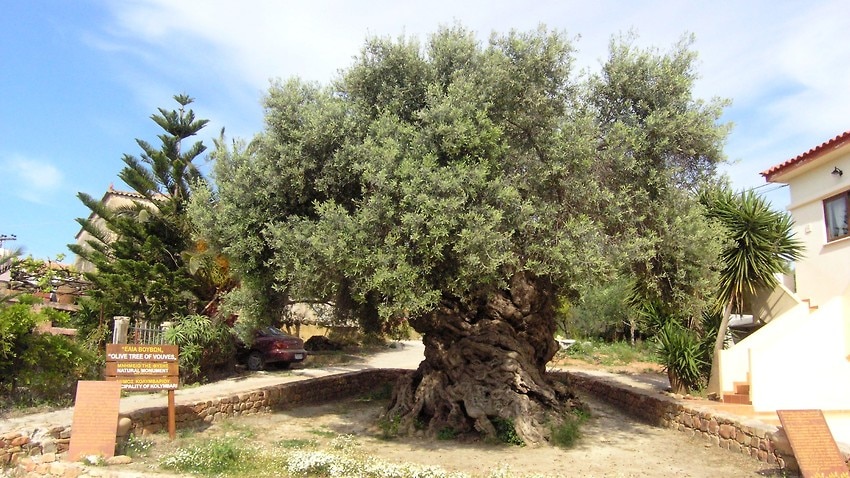
2. Al Badawi Olive Tree – Bethlehem, West Bank
Located in the village of Al Walaja, the Al-Badawi tree is believed to be couple thousand years old. This mighty tree reaches 40 feet (12 meters) in height and continues to be a significant source of olives for the local community.
These trees show us the incredible longevity of olive trees and how they can thrive for thousands of years with the right care and conditions.
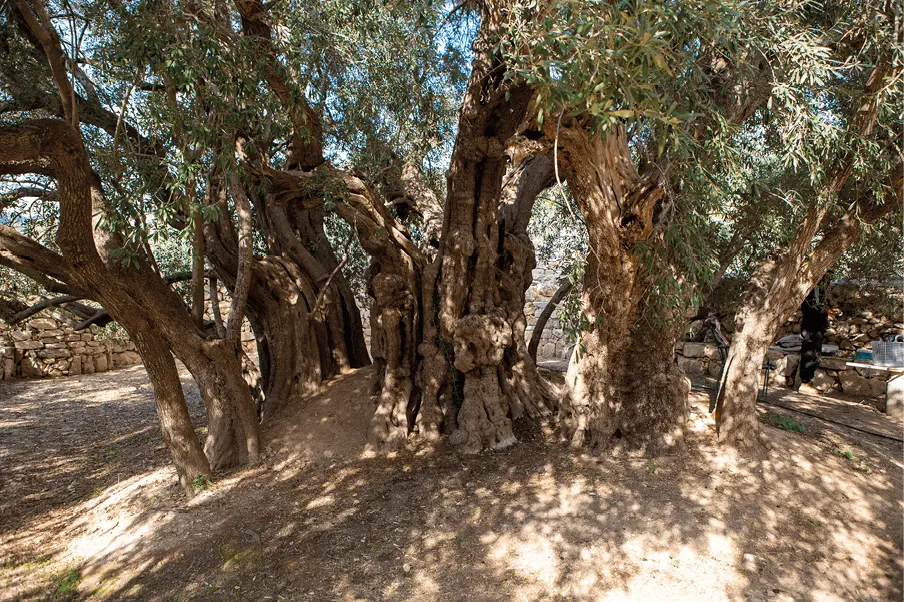
3. The Farga de l’Arión – Ulldecona, Spain
Suppose you take a journey to Ulldecona, Spain, where the ancient Farga de l’Arión stands towering up to 46 feet (approximately 14 meters) high. It offers a unique glimpse into the past, estimated at around 1,700 years old.
From its thick, gnarled trunk to the sprawling canopy of silver-green leaves, the Farga de l’Arión’s grandeur and age reflect the incredible resilience and long-lived nature of olive trees
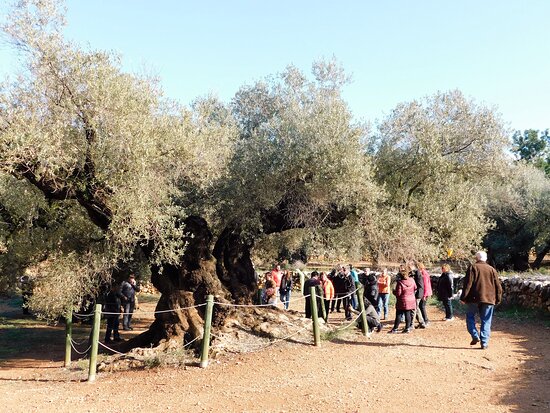
4. The Patriarch of Nature – Luras, Sardinia, Italy
Luras is home to the illustrious Patriarch of Nature in Sardinia, Italy. This awe-inspiring olive tree soars to an impressive 36 feet (about 11 meters) high and carries the weight of history in its branches, with an estimated age of over 3,000 years.
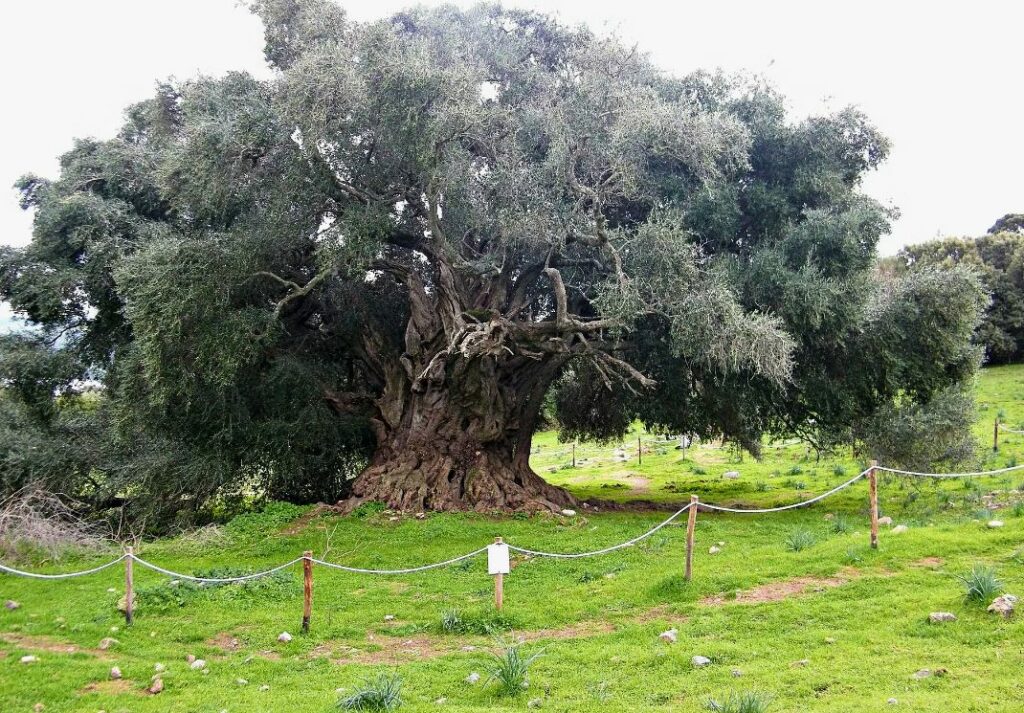
V. Comparing Olive Trees’ Height to Other Fruit Trees
If you want to grow multiple fruit trees and plan your landscape design, let’s discuss olive trees against other popular fruit bearers: citrus, apple, and peach. Let’s see how they stack up in terms of height!
1. Comparison with Citrus Trees
First up, let’s talk citrus. Citrus trees, like lemons, oranges, or grapefruits, are quite similar to olive trees in height.
Standard citrus trees usually range from 15 to 30 feet (4.5 to 9 meters) tall, which is pretty close to the height of a standard olive tree. Dwarf and semi-dwarf varieties of these trees are comparable too, usually staying below 15 feet (4.5 meters).
2. Comparison with Apple Trees
Next on our list is the classic apple tree. Did you know that apple trees, particularly those grown for commercial production, come in different sizes based on their rootstock?
Dwarf apple trees can grow from 8 to 10 feet (2.4 to 3 meters) tall, while semi-dwarf varieties can reach 12 to 15 feet (3.5 to 4.5 meters). Standard apple trees, meanwhile, can grow up to 20 feet (6 meters) or more, similar to full-sized olive trees.
3. Comparison with Peach Trees
Finally, let’s look at peach trees. Standard peach trees typically reach about 15-25 feet (4.6-7.6 meters) in height, making them a bit shorter than full-sized olive trees.
They also have a shorter lifespan than olive trees, so your olive tree may outlive and outgrow your peach tree over the years.
| Fruit Tree | Standard Height (feet) | Standard Height (meters) |
| Olive | 20-30+ | 6.1-9.1+ |
| Citrus (e.g., Lemon, Orange) | 15-30 | 4.6-9.1 |
| Apple | 20+ | 6.1+ |
| Peach | 15-25 | 4.6-7.6 |
Note: Height ranges are approximate, as they can vary based on the specific variety, local environment, and care practices.
Searching for Premium Olive Oil?
Get OLIVIADA Olive Oil from Kalamata, GREECE!
VI. Factors Influencing the Height of Olive Trees
Based on my years of experience and observation, three key factors govern how tall an olive tree can grow: genetics, environment, and cultivation practices.
1. Genetic Factors
Just like us humans, each olive tree comes with its own set of genetic instructions that determine its characteristics, including its height. These traits are passed on from parent trees to offspring, like how your hair or eye color might resemble your parents.
When it comes to olive trees, there are hundreds of varieties, each with its unique genetic blueprint. Dwarf varieties like ‘Little Ollie’ or ‘Skylark Dwarf’ are genetically predisposed to stay smaller, usually under 10 feet (3 meters) tall. Semi-dwarf varieties like ‘Arbequina’ or ‘Koroneiki’ naturally grow slightly taller, typically reaching heights between 10 and 20 feet (3 and 6 meters). And then, of course, there are the standard or full-sized olive tree varieties like ‘Mission’ or ‘Manzanillo’ that can tower up to 30 feet (9 meters) or even more.
But remember, while genetics provide the blueprint, the environmental and care factors determine how closely an olive tree will follow it. Just as a child can be tall or short depending on their nutrition and overall health, olive trees can grow taller or shorter based on how they’re cared for.
2. Environmental Factors
Alright, now that we’ve delved into the genetics of olive trees, let’s step outside and talk about environmental factors. Specifically, I want to chat about how climate and weather conditions can affect the height of your olive trees.
a. Climate and Weather Conditions
Olive trees are real sun lovers. They crave sunlight and do their best growing in areas where they can soak up plenty of it. The Mediterranean climate, with its hot summers and mild winters, is perfect for olive trees. But that doesn’t mean you can’t successfully grow them in other climates!
Olive trees can be surprisingly hardy, tolerating colder temperatures and frost better than many people realize. However, prolonged freezing temperatures or excessive rainfall can hinder their growth, possibly stunting their height. Conversely, the more sunlight and warmth your trees get, the more energy they have to put into growing taller.
Also, check where olive trees grow best.
b. Soil Type and Nutrition
Have you ever heard the saying, “You are what you eat”? Well, that applies to olive trees too! Soil type and nutrition determine how tall an olive tree can grow.
Let’s start with the basics: olive trees aren’t too picky about their soil. They can grow in various soil types, from sandy to clayey. However, they do have a preference for well-drained, slightly alkaline soil. This is because waterlogged soils can lead to root rot, stunting growth, or even killing the tree.
Last update on 2024-04-21 / Affiliate links / Images from Amazon Product Advertising API
In my experience as an olive tree grower, I’ve found that olive trees appreciate soil rich in organic matter. Compost or well-rotted manure can provide this organic matter, offering the tree a steady supply of nutrients. If your soil is naturally poor or heavy with clay, adding organic matter can make a world of difference to your tree’s health and height.
Last update on 2024-04-21 / Affiliate links / Images from Amazon Product Advertising API
Regarding nutrition, olive trees have three main needs: nitrogen, phosphorus, and potassium. Nitrogen promotes leafy growth, phosphorus aids root development, and potassium is essential for flowering and fruiting. A well-balanced fertilizer can help provide these essential nutrients and boost your tree’s growth.
Last update on 2024-04-21 / Affiliate links / Images from Amazon Product Advertising API
But remember: balance is the key. Over-fertilization can lead to excessive leafy growth at the expense of fruit production, and it can also make your tree more susceptible to disease.
Relevant article: best soil for olive trees in pot, cultivating olive trees – soil management, best fertilizer for olive trees.
3. Cultivation and Care Factors
a. Pruning Practices
Pruning an olive tree isn’t just about maintaining its shape or controlling its size; it’s also about encouraging growth. When you prune an olive tree, you’re helping to direct the tree’s energy toward new growth and fruit production.
But how does pruning influence the height of your olive tree? Well, if you prune your olive tree to maintain a shorter, bushier shape, this can limit its vertical growth. On the other hand, if you let your tree grow without much pruning, it’s more likely to shoot up and reach its genetically determined height.
Remember, different types of pruning can stimulate different kinds of growth:
- Light pruning, for instance, generally stimulates vertical growth, helping your tree to grow taller.
- Heavier pruning, on the other hand, can encourage bushier growth.
I recommend a balanced approach: aim for a tree that’s not too tall for you to manage, but still tall enough to allow for good air circulation and sunlight penetration.
Also, read formative pruning, how to prune olive trees in pots.
b. Watering and Sunlight Exposure
Olive trees need a full day’s sunlight (6 to 8 hours) to thrive. So, planting your olive tree in a spot where it can soak up the maximum amount of sunlight is a good step towards encouraging it to grow taller. The energy it gets from the sun is directly converted into growth energy. That’s why in sunny Mediterranean climates, you’ll see olive trees reaching their full height potential.
Watering, however, is a bit of a balancing act. Too much water and your olive tree’s roots can become waterlogged, leading to root rot. Too little water and your tree may become dehydrated, stunting its growth. Olive trees are drought-resistant, meaning they can survive with less water, but regular watering is beneficial for optimal growth.
As a rule of thumb, I water my young olive trees once a week, but as they mature and their root systems become more established, I water them less frequently. If you’re unsure how much to water, a good strategy is to let the soil dry out between watering sessions.
Lastly, it’s important to remember that the watering needs of your tree may change with the seasons. For example, your olive tree might need more frequent watering during hot, dry summers.
Read more about watering requirements for potted olive trees, cultivating olive trees: irrigation.
VII. Methods to Control the Height of Olive Trees
1. Pruning Techniques
Let’s start with the basics. The best time to prune an olive tree is in late winter or early spring, just before the new growth starts. This gives your tree the whole growing season to recover and put energy into new growth.
When controlling height, the rule is to keep the central leader (the main trunk) pruned if you want your tree to stay short. Removing the central leader will cause the tree to grow outwards rather than upwards, keeping it short and bushy.
You’ll need to be a little more strategic for a tree that’s already too tall. Look for the “collar” at the base of a branch (the swollen area where it joins the trunk) and make your cut there. This helps the tree to heal quickly and reduces the chance of disease.
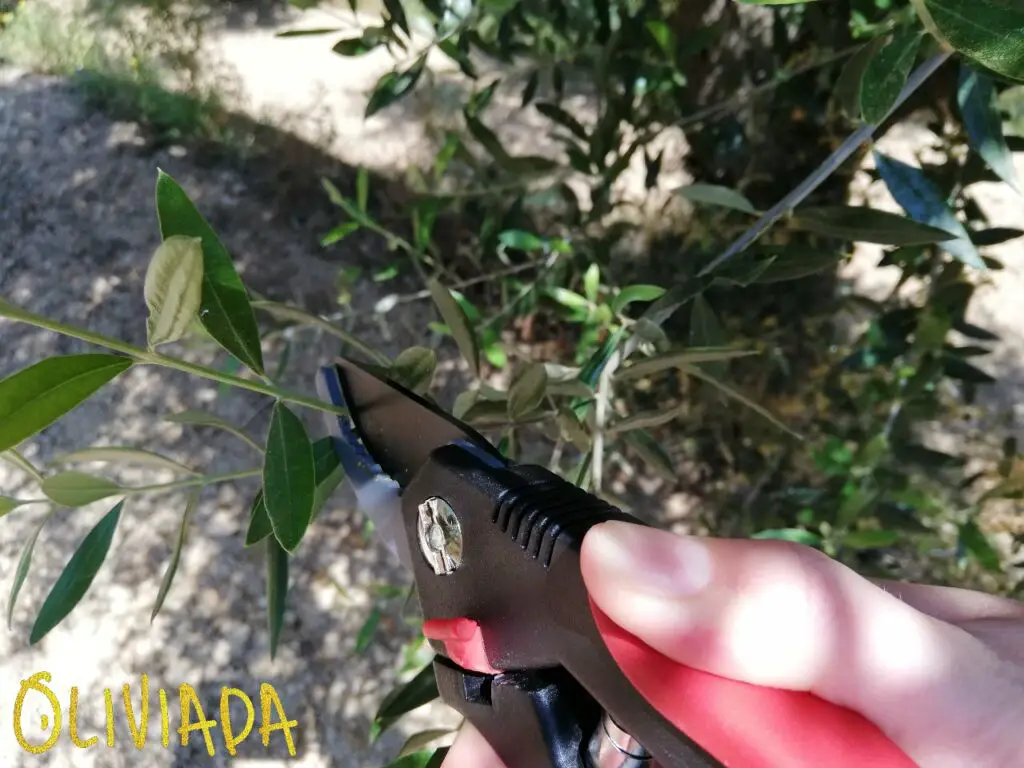
But remember, pruning should be a gentle process. Never remove more than one-third of your tree’s total foliage in one year. Over-pruning can stress the tree and hinder its growth.
And here’s a final tip: always use sharp, clean pruning tools. Dull or dirty tools can damage your tree and introduce disease. It’s worth investing in a good pair of pruning shears and cleaning them properly after each use.
2. Planting Methods
The way you plant your olive tree can influence its height. Let’s start at the beginning – choosing the right location.
Olive trees need full sun and well-drained soil to thrive. Planting it in a spot shielded from wind can prevent it from growing too tall, as exposure to wind often encourages trees to grow taller and stronger to withstand the elements.
The way you prepare your planting hole can also make a difference. Here’s a secret: a deep planting hole encourages root growth downwards rather than outwards, which can help your tree grow taller. So, if you’re aiming for a tall, majestic olive tree, dig a little deeper.
On the other hand, if you’re hoping to limit your tree’s height, consider planting it in a container. Potted olive trees tend to be smaller, as their root growth – and therefore, their overall size – is restricted by the pot. This can be a great strategy if you’re working with limited space or simply prefer a smaller tree.
3. Ideal Conditions for Desired Height
If you’re aiming for a taller olive tree, give it plenty of room to grow. A spacious area will encourage the tree to spread out and reach its full height potential. Pair this with a rich, deep soil that’s regularly watered, and you’ll have an environment conducive to height growth.
Ensure it has full sun exposure and is protected from strong winds. A taller tree will need more sunlight to support its higher energy needs. And while olive trees are fairly wind-resistant, protection from harsh wind can help the tree channel more of its resources into height growth, rather than developing wind-resistant strength.
Now, if a shorter, more compact olive tree is what you’re after, consider planting it in a pot or container. The limited root space naturally restricts the tree’s height. Just be mindful that potted trees still need good drainage to avoid root rot. Even in a container, your olive tree will still need plenty of sunlight, so a sunny spot on your patio or balcony would be ideal.
Pruning also becomes even more important with potted olive trees. Regular pruning helps control height and encourages bushier growth, keeping your potted tree looking lush and full.
VIII. How the Height of Olive Tree Impacts Olive Production
As an experienced olive tree grower, I’ve come to understand that the height of your olive tree doesn’t just affect its stature—it also substantially impacts olive production. Let’s delve into this a little deeper.
1. Correlation between Tree Height and Fruit Production
From my observations, a taller olive tree tends to bear more fruit, given its increased leaf canopy. It’s quite logical when you think about it. A larger tree will have more branches, leaves, and consequently, more space for those delicious olives to grow.
But remember, while a tall tree might seem like a jackpot with abundant fruit, it doesn’t automatically equate to a higher-quality harvest. It’s a careful balancing act because as the tree grows in size, it also requires more nutrients to maintain its health and productivity.
That said, a smaller, well-pruned, and well-maintained olive tree can still be a heavy hitter regarding quality fruit production. Even though it might not match a larger tree in sheer quantity, the quality of the olives may well be superior, with proper care and attention.
2. Impact of Tree Height on Harvesting
Taller olive trees, with their impressive height, present unique challenges during the harvest season. The lofty branches often require ladders or long-handled tools to reach. As you can imagine, this isn’t just physically demanding but also requires more time and labor to complete. And that’s not the end of it.
Harvesting from a tall tree, particularly using mechanical equipment, can sometimes result in more damaged fruit. The olives might be bumped, bruised, or dropped from a greater height, potentially impacting their quality.
Now, don’t get me wrong. This doesn’t mean you should shy away from growing taller olive trees. Not at all! It’s just a factor to be aware of, and it can be managed effectively with the right planning and equipment.
But, if you’re a small-scale grower or gardener looking for an easier harvest, you might consider keeping your olive trees at a more manageable height. This can be achieved through careful pruning, which not only makes harvesting easier but can also help to maintain the overall health and productivity of your trees.
3. Influence on Quality and Quantity of Olives
As a seasoned olive tree grower, I often get asked this question: “Does the height of my olive tree affect the quality and quantity of the olives?” I can tell you that, yes, it indeed does.
On the one hand, taller olive trees generally have a larger leaf area and more branches. This translates to more olives, as there are more spots for the olives to grow. So, if you’re chasing quantity, letting your tree reach its natural height might be the way to go.
However, there’s an important flip side to this equation. From my observations, maintaining a taller olive tree can be more challenging. It can be tougher to ensure that the nutrients from the soil are adequately reaching the taller branches. This can, in some instances, affect the overall health of the tree and, as a result, the quality of the olives it produces.
What I’ve found is that a smaller, well-nurtured olive tree can often produce olives of a higher quality. These trees are easier to care for and monitor, allowing you to catch any signs of disease or pest infestations earlier. This means healthier trees and, subsequently, superior olives.
Essentially, it’s a trade-off: the quantity of a taller tree versus the potential quality of a smaller one. The key is understanding your olive-growing goals and adjusting your tree care practices accordingly.
IX. Frequently Asked Questions
Are olive trees fast or slow-growing?
Olive trees are considered slow to moderate growers. They may grow about 1 to 2 feet (30 to 60 cm) per year under ideal conditions. However, remember that growth can be influenced by various factors, including the tree’s genetics, environment, and overall care.
Do olive trees grow taller in the ground or in pots?
Generally, olive trees grow taller when planted in the ground. The confined space of a pot naturally restricts the growth of the tree. However, potted olive trees can still grow tall and healthy with the right care and conditions.
How long does it take for an olive tree to reach full height?
An olive tree can take between 30 to 40 years to reach its full height, given optimal conditions. However, the growth rate can vary significantly based on genetic, environmental, and cultivation factors.
How long does it take for an olive tree to bear fruit?
From the planting time, it typically takes 3 to 5 years for an olive tree to start bearing fruit. However, substantial, harvestable yields often start from the 5th year onward. These timelines can vary based on the variety of the olive tree and the conditions in which it’s grown.
How much space does an olive tree need?
I recommend leaving at least 20 feet (6 meters) of space between each tree if you’re planting in the ground. This gives them ample room to spread their branches and ensures they get plenty of sunlight. If you’re planting in a pot, choose one at least 20 inches (50 cm) in diameter.
X. Conclusion
The height of an olive tree doesn’t just add to its majesty; it directly impacts its productivity and the ease of olive harvesting. A tree’s height can significantly influence the quantity and quality of olives, shaping the commercial viability of an olive farm.
Remember that the heights mentioned here are not strict rules but guides. Many factors, like the tree’s genetics, the climate, the soil, and your care, will determine how tall your tree grows.
I hope this exploration has been as informative for you as it was when I started this journey. Here’s to growing and learning with our magnificent olive trees!
XI. References
For those who want to dive deeper into the fascinating world of olive trees, I’ve compiled a list of resources that can help in a journey as an olive tree grower:
- “Olive Production Manual” by G. S. Sibbett and L. Ferguson. This comprehensive guide provides insights into all aspects of olive production, from planting to harvesting.
- “Pruning and Training Systems for Modern Olive Growing” by R. Gucci and C. Cantini. A practical guide for olive growers seeking to optimize their trees for production.
- “The Complete Idiot’s Guide to Year-Round Gardening” by D. Smittle and S. A. Richerson. While not solely about olive trees, this book offers practical advice on growing a wide variety of plants, including olive trees.
- “Origin and History of the Olive” by C. M. Breton and P. Warnock. A captivating exploration of the olive tree’s origin and place in Mediterranean culture and history.
- Websites like Olive Oil Times and International Olive Council. These websites offer information on olive-related things, from the latest industry news to practical growing tips.
Related Topics
- Olive Tree Lifespan
- Olive Tree Grow Best Conditions
- Olive Tree Growth Rate
- Olive Tree Root System: Invasive or Not
Hi, I’m Vangelis Kleftogiannis, the founder of Oliviada and an established olive oil expert from Kalamata, Greece. My expertise isn’t just in producing quality Extra Virgin Olive Oil, but also in the cultivation and care of olive trees themselves. I am deeply committed to sharing my knowledge and know-how, helping others understand the intricacies of olive tree growing and the creation of quality olive oil.
Are You Looking to Buy an Olive Tree?
If you are looking to add more potted trees or other plants to your orchard, or if you like to replace a neglected olive tree, the best places to get them are your local nursery or an online nursery.
One of the most reliable and the world's largest online nurseries is Fast Growing Trees. They deliver fast, neat, and healthy plants backed with a 30-day guarantee.




